Badsey’s Big Dig
- 31st March 2023
In May 2022, 19 test pits were excavated across Badsey village as part of the Small Pits, Big Ideas project. Badsey is known to be in an area where there is evidence of early activity, but what could we find out about the medieval village?
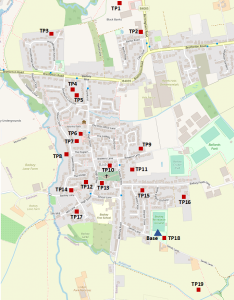
Map showing locations of test pits in Badsey Source: Open Street Map Data
What is a test pit?
Test pits are mini excavation areas, just 1m by 1m. They are dug in 10cm layers (called ‘spits’) with the finds from each spit kept separately, so that it’s known how deep down they were found. Test pits were mostly excavated down to the ‘natural’, which is the point at which archaeology stops and undisturbed geology begins. The depth of the Bewdley test pits varied quite widely, ranging from 0.3m – 1.4m below ground level.
What do we already know?
Badsey is first mentioned in a charter of 709 AD as Baddesia (‘Baeddi’s Island) and at the time of the Domesday survey of 1086 it consisted of 17 individual households or dwellings, including 8 ploughs. This number of ploughs in the village suggests that arable farming was well established in Badsey at this time, and the number of households suggests that it was a reasonable sized settlement. Badsey sits in southeast Worcestershire, an area where much evidence of prehistoric and Roman settlement has been found along the River Avon. Several Anglo-Saxon coins have also been found in the parish, providing evidence of Anglo-Saxon activity that is not commonly seen in Worcestershire.
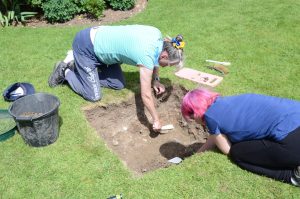
Digging a test pit Photo – Tony Spinks, The Badsey Society
So, what did we find?
Given evidence of early settlement in the area, it is no surprise that this is reflected in the test pits. This was particularly true for Roman material – half of Badsey’s test pits produced Roman finds whilst only 6 yielded medieval pottery, which is less than expected. It is possible that this indicates a higher density of Roman occupation in the area than during the medieval period, but this is a big leap to make from a small amount of evidence and there may be other explanations for the difference.
The only test pit that produced undisturbed medieval archaeology was Test Pit 13, located next to St James’ Church. The majority of this medieval material was local in origin, mainly sherds of Worcester cooking pots. Interestingly though, a piece of 12th – 13th century ‘Newbury B ware’ from Wiltshire was found in a test pit near the High Street. This is a rare find in Worcestershire, having turned up at only a handful of sites in the county. Similarly, a sherd of a 13th – 14th century Buckinghamshire ‘Brill-Boarstall ware’ jug was also found, suggesting an element of travel of people and objects not always associated with the medieval era.
Finds from Test Pit 13 in particular provide an indication of activity around the church from the Roman period through to the modern period and this test pit was the only one to do so. A small group of medieval pottery sherds, recovered as might be expected from the lower layers of the pit, give a date contemporary with the adjacent church and provide some additional confirmation that this area of Badsey has been occupied consistently from the early medieval period.
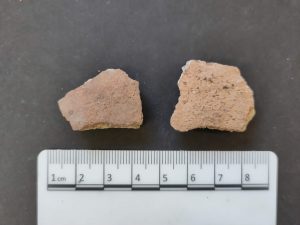
The sherd on the left is Worcester cooking pot, and the sherd on the right is ‘Newbury B Ware’. This really shows the precise skills of finds specialists!
What did the medieval village look like?
It seems that medieval settlement was more nucleated at Badsey than other villages we have investigated as part of the Small Pits project. Most of the medieval finds are concentrated quite closely together in the more central test pits than in those slightly further out. Unlike the Roman material produced from test pits across the village, the medieval finds were located in the southern end of the present settlement, indicating that this would have been the medieval village centre – probably clustered around St James’s Church.
It seems that rubbish from houses was discarded near-by, rather than spread across fields with manure, as seen in other villages. However, the village of Badsey sits in one corner of a large parish, so it may be that this scatter occurred outside of the areas we investigated. Also, we know that the parish boundary has moved recently, meaning the northern part of the area we investigated was once in the parish of Aldington.
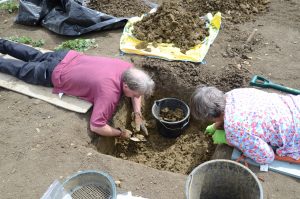
Digging a test pit
Photo – Tony Spinks, The Badsey Society
The later village
Finds from Badsey show that occupation continued in the area after the medieval period and onwards. As well as sherds of 17th and 18th century pottery such as black-glazed red wares and buff ware, of particular note is a button mold. A popular object in the 1700s, button molds would have been covered in cloth or thread to match an individual’s clothing.
Historic mapping shows Badsey was a relatively modest-sized village until the late nineteenth century, when it increased in size dramatically due to the market gardening industry developing across the Vale of Evesham.
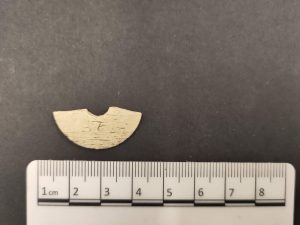 Part of an 18th Century button mold |
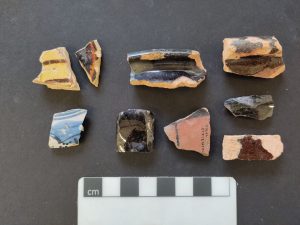 Sherds of 17th and 18th Century Pottery, including slipware, black glazed red ware and tin glazed ware |
Want to know more?
Keep an eye out for the full report on Bewdley’s Big Dig, which will be available from our website soon. In the meantime, a video of a talk given to the village in March 2023 is available via our YouTube Channel.
Post a Comment